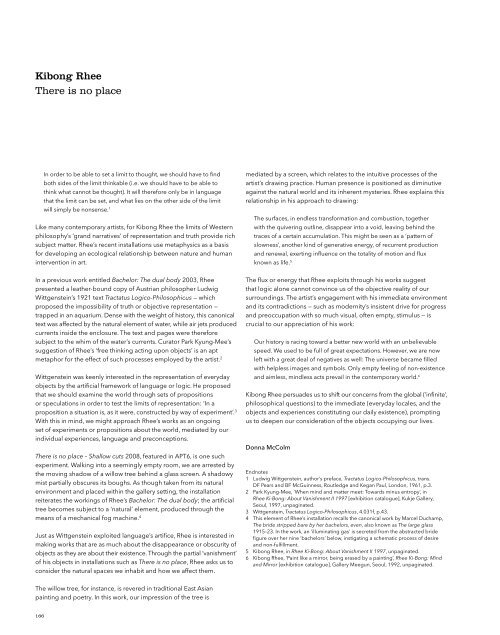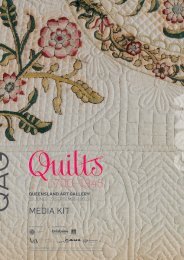Queensland Art Gallery - Queensland Government
Queensland Art Gallery - Queensland Government
Queensland Art Gallery - Queensland Government
Create successful ePaper yourself
Turn your PDF publications into a flip-book with our unique Google optimized e-Paper software.
Kibong Rhee<br />
There is no place<br />
In order to be able to set a limit to thought, we should have to find<br />
both sides of the limit thinkable (i.e. we should have to be able to<br />
think what cannot be thought). It will therefore only be in language<br />
that the limit can be set, and what lies on the other side of the limit<br />
will simply be nonsense. 1<br />
Like many contemporary artists, for Kibong Rhee the limits of Western<br />
philosophy’s ‘grand narratives’ of representation and truth provide rich<br />
subject matter. Rhee’s recent installations use metaphysics as a basis<br />
for developing an ecological relationship between nature and human<br />
intervention in art.<br />
mediated by a screen, which relates to the intuitive processes of the<br />
artist’s drawing practice. Human presence is positioned as diminutive<br />
against the natural world and its inherent mysteries. Rhee explains this<br />
relationship in his approach to drawing:<br />
The surfaces, in endless transformation and combustion, together<br />
with the quivering outline, disappear into a void, leaving behind the<br />
traces of a certain accumulation. This might be seen as a ‘pattern of<br />
slowness’, another kind of generative energy, of recurrent production<br />
and renewal, exerting influence on the totality of motion and flux<br />
known as life. 5<br />
In a previous work entitled Bachelor: The dual body 2003, Rhee<br />
presented a leather-bound copy of Austrian philosopher Ludwig<br />
Wittgenstein’s 1921 text Tractatus Logico-Philosophicus — which<br />
proposed the impossibility of truth or objective representation —<br />
trapped in an aquarium. Dense with the weight of history, this canonical<br />
text was affected by the natural element of water, while air jets produced<br />
currents inside the enclosure. The text and pages were therefore<br />
subject to the whim of the water’s currents. Curator Park Kyung-Mee’s<br />
suggestion of Rhee’s ‘free thinking acting upon objects’ is an apt<br />
metaphor for the effect of such processes employed by the artist. 2<br />
Wittgenstein was keenly interested in the representation of everyday<br />
objects by the artificial framework of language or logic. He proposed<br />
that we should examine the world through sets of propositions<br />
or speculations in order to test the limits of representation: ‘In a<br />
proposition a situation is, as it were, constructed by way of experiment’. 3<br />
With this in mind, we might approach Rhee’s works as an ongoing<br />
set of experiments or propositions about the world, mediated by our<br />
individual experiences, language and preconceptions.<br />
There is no place – Shallow cuts 2008, featured in APT6, is one such<br />
experiment. Walking into a seemingly empty room, we are arrested by<br />
the moving shadow of a willow tree behind a glass screen. A shadowy<br />
mist partially obscures its boughs. As though taken from its natural<br />
environment and placed within the gallery setting, the installation<br />
reiterates the workings of Rhee’s Bachelor: The dual body; the artificial<br />
tree becomes subject to a ‘natural’ element, produced through the<br />
means of a mechanical fog machine. 4<br />
Just as Wittgenstein exploited language’s artifice, Rhee is interested in<br />
making works that are as much about the disappearance or obscurity of<br />
objects as they are about their existence. Through the partial ‘vanishment’<br />
of his objects in installations such as There is no place, Rhee asks us to<br />
consider the natural spaces we inhabit and how we affect them.<br />
The willow tree, for instance, is revered in traditional East Asian<br />
painting and poetry. In this work, our impression of the tree is<br />
The flux or energy that Rhee exploits through his works suggest<br />
that logic alone cannot convince us of the objective reality of our<br />
surroundings. The artist’s engagement with his immediate environment<br />
and its contradictions — such as modernity’s insistent drive for progress<br />
and preoccupation with so much visual, often empty, stimulus — is<br />
crucial to our appreciation of his work:<br />
Our history is racing toward a better new world with an unbelievable<br />
speed. We used to be full of great expectations. However, we are now<br />
left with a great deal of negatives as well: The universe became filled<br />
with helpless images and symbols. Only empty feeling of non-existence<br />
and aimless, mindless acts prevail in the contemporary world. 6<br />
Kibong Rhee persuades us to shift our concerns from the global (‘infinite’,<br />
philosophical questions) to the immediate (everyday locales, and the<br />
objects and experiences constituting our daily existence), prompting<br />
us to deepen our consideration of the objects occupying our lives.<br />
Donna McColm<br />
Endnotes<br />
1 Ludwig Wittgenstein, author’s preface, Tractatus Logico-Philosophicus, trans.<br />
DF Pears and BF McGuinness, Routledge and Kegan Paul, London, 1961, p.3.<br />
2 Park Kyung-Mee, ‘When mind and matter meet: Towards minus entropy’, in<br />
Rhee Ki-Bong: About Vanishment II 1997 [exhibition catalogue], Kukje <strong>Gallery</strong>,<br />
Seoul, 1997, unpaginated.<br />
3 Wittgenstein, Tractatus Logico-Philosophicus, 4.031f, p.43.<br />
4 This element of Rhee’s installation recalls the canonical work by Marcel Duchamp,<br />
The bride stripped bare by her bachelors, even, also known as The large glass<br />
1915–23. In the work, an ‘illuminating gas’ is secreted from the abstracted bride<br />
figure over her nine ‘bachelors’ below, instigating a schematic process of desire<br />
and non-fulfillment.<br />
5 Kibong Rhee, in Rhee Ki-Bong: About Vanishment II 1997, unpaginated.<br />
6 Kibong Rhee, ‘Paint like a mirror, being erased by a painting’, Rhee Ki-Bong: Mind<br />
and Mirror [exhibition catalogue], <strong>Gallery</strong> Meegun, Seoul, 1992, unpaginated.<br />
Kibong Rhee<br />
South Korea b.1957<br />
There is no place – Shallow cuts 2008<br />
Glass, fog machine, artificial leaves, wood, steel, sand,<br />
motor, timer / Installation views, Kukje <strong>Gallery</strong>, Seoul /<br />
Images courtesy: The artist and Kukje <strong>Gallery</strong>, Seoul<br />
166 167
















